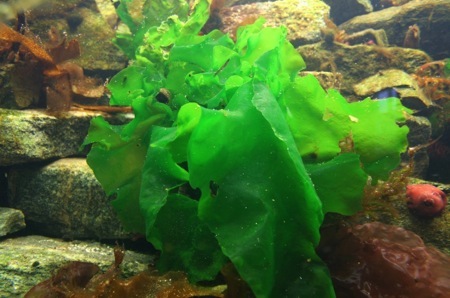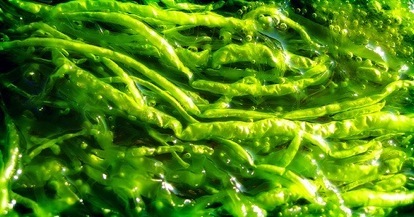Ulva: Sea Soup & Salad
Ulva is the greenest seaweed you will ever see from shore, or in the sea for that matter.
Ten species, all edible, are found around the world in cool water. Ulva (ULL-vah, rhymes with hull) is commonly found on intertidal rocks, in tide pools, on reef flats, growing on shells, piling, pieces of wood, other seaweed or free-floating. It also favors areas of fresh water runoff that are rich in nutrients (particularly nitrogen) such as the mouths of rivers, streams and run-off pipes (the latter not the wisest place to harvest food.) Ulva can grow profusely in those areas and it is one of the most commonly encountered seaweeds. Here in Florida it is most often seen on jetties at low tide. In fact, there has been a decades long breeding program in the state to develop a variety that can be commercially grown in warmer waters.
Despite looking flimsy Ulva is quite strong for leaves only two cells thick. Think if it as wet wax paper with some resistance. Despite that it can easily be harvested, in or out of the water. Its most common use is to add it to soups and salads. Nutritionally Ulva has 87 mg of iron per 100 gram portion and 700 mg calcium per 100 gram serving. U. lactuca is made of 15% protein, 50% sugar and starch, less than 1% fat. It is also high in protein, iodine, aluminum, manganese and nickel and contains Vitamin A, Vitamin B1, Vitamin C, sodium, potassium, magnesium, calcium, soluble nitrogen, phosphorous, chloride, silicon, rubidium, strontium, barium, radium, cobalt, boron, trace elements, ash, fiber and the kitchen sink…
Commonly called Sea Lettuce or Green Laver, it can also used as a substitute for nori (see Porphyra) a seaweed used in sushi. Ulva should be washed well then use or as an option soak it in water for two hours before using to moderate the flavor. Besides soups and salads it can even be toasted over charcoal. When toasted it add yet another flavor to soups and salads. Ulva can be store for two or three days in the refrigerator or frozen for six months without loss of flavor. Further Ulva can be dried and used as a powder. When its blades (leafs) are dried they darken and are brittle. It should be air-dried or pressed into thin sheets. Drying in the sun is best though you can also use an oven. And in the end, if you don’t like it, Ulva can be used as animal fodder. Personally, I like it. A restaurant in Port Canaveral, Florida, used to serve Ulva fresh in a “seaweed salad” that was quite good. One combination for a seaweed salad is Ulva lactuca, Ulva enteromorpha and Ulva monostroma, known collectively as aonori. In texture and flavor Ulva reminds me of shreaded jelly fish… I know that’s not much of a help but I find it tasty. Ulva is also dried, salted and sold in South America as “cachiyugo.”
The most famous species is Ulva lactuca. In Latin Ulva means “sedge.” In this case Ulva was one of the first plants to get a scientific name and Ulva was used in the sense to mean a swamp grass. As it resembled wild lettuce it got the name given to lettuce, lactuca, which means milk bearing. Wild lettuce on land has a white sap. Generally Ulva is called Sea Lettuce. Avoid any seaweed, Ulva or otherwise, that has blue-green algae on it.
Sea Lettuce Soup
4 cups chicken stock
2 sheets Ulva
2 eggs
Salt and pepper
½ tsp sesame oil
1 or 2 green scallions
Bring stock to a boil. Add sea lettuce and
stir. When sea lettuce is soft, stir in well-
beaten eggs and boil for a few seconds then
remove from heat. Add salt and pepper to
taste. Add sesame oil, garnish with onion,
and serve.
Toasted Sea Lettuce
6 sheets Ulva
½ tsp Salt
1 ½ tablespoon sesame oil
Mix salt and sesame oil and rub a thin coat on sea lettuce. Lay 6 sheets on top of one another, roll them up and let them marinade for 5 minutes. Unroll and cook each sheet separately in a hot pan over low heat until crisp. Cut sheet into smaller pieces and serve with hot rice.
Green Deane’s “Itemized” Plant Profile
IDENTIFICATION: Thin, sheet-like, as tufts or solitary blades, shape varies, to one three feet. Blades (leaves) ruffled or flat, small microscopic teeth on edges. Bright green to dark green, gold edges when reproducing. In some species the blades have holes in them.
TIME OF YEAR: Generally year round.
ENVIRONMENT: Ulva lives attached when young to rocks in the middle to low intertidal zone, and as deep as 35 feet in calm, protected waters. Usually seen in dense colony. It is often offers a hiding place for blue crabs. Older it is free-floating.
METHOD OF PREPARATION: Raw or cooked, in salads or soups, chopped as a relish, a late ingredient to stir fries. Can be dried and added as a power to other foods. Or, chop it up, boil for a half an hour, mix with grated cheese and oatmeal, form into patties and fry. Sea Lettuce fritters. The blades can also be used as a wrap, raw or cooked or for cooking, such as wrapping one around a shrimp before frying. Ulva can be microwaved on low power for three or so minutes.
HERB BLURB
Ulva has been used to treat burns and gout. It is a natural source of iodine and is an astringent.



